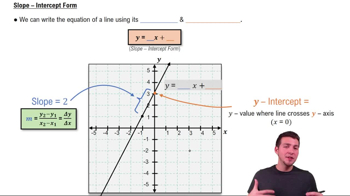Table of contents
- 0. Functions7h 52m
- Introduction to Functions16m
- Piecewise Functions10m
- Properties of Functions9m
- Common Functions1h 8m
- Transformations5m
- Combining Functions27m
- Exponent rules32m
- Exponential Functions28m
- Logarithmic Functions24m
- Properties of Logarithms34m
- Exponential & Logarithmic Equations35m
- Introduction to Trigonometric Functions38m
- Graphs of Trigonometric Functions44m
- Trigonometric Identities47m
- Inverse Trigonometric Functions48m
- 1. Limits and Continuity2h 2m
- 2. Intro to Derivatives1h 33m
- 3. Techniques of Differentiation3h 18m
- 4. Applications of Derivatives2h 38m
- 5. Graphical Applications of Derivatives6h 2m
- 6. Derivatives of Inverse, Exponential, & Logarithmic Functions2h 37m
- 7. Antiderivatives & Indefinite Integrals1h 26m
- 8. Definite Integrals4h 44m
- 9. Graphical Applications of Integrals2h 27m
- 10. Physics Applications of Integrals 2h 22m
3. Techniques of Differentiation
The Chain Rule
Problem 3.7.109b
Textbook Question
109-112 {Use of Tech} Calculating limits The following limits are the derivatives of a composite function g at a point a.
b. Use the Chain Rule to find each limit. Verify your answer by using a calculator.
 Verified step by step guidance
Verified step by step guidance1
Step 1: Recognize that the given limit is in the form of a derivative. Specifically, it resembles the definition of the derivative of a function at a point, which is \( \lim_{x \to a} \frac{f(x) - f(a)}{x - a} \).
Step 2: Identify the inner function \( u(x) = x^2 - 3 \) and the outer function \( h(u) = u^5 \). The composite function is \( g(x) = h(u(x)) = (x^2 - 3)^5 \).
Step 3: Apply the Chain Rule to find the derivative of \( g(x) \) at \( x = 2 \). The Chain Rule states that \( g'(x) = h'(u(x)) \cdot u'(x) \).
Step 4: Calculate \( u'(x) \), the derivative of the inner function: \( u'(x) = \frac{d}{dx}(x^2 - 3) = 2x \).
Step 5: Calculate \( h'(u) \), the derivative of the outer function: \( h'(u) = \frac{d}{du}(u^5) = 5u^4 \). Evaluate \( h'(u) \) at \( u = u(2) = 1 \), and use these derivatives to find \( g'(2) \).
 Verified video answer for a similar problem:
Verified video answer for a similar problem:This video solution was recommended by our tutors as helpful for the problem above
Video duration:
5mPlay a video:
Was this helpful?
Key Concepts
Here are the essential concepts you must grasp in order to answer the question correctly.
Limits
Limits are fundamental in calculus, representing the value that a function approaches as the input approaches a certain point. In this context, the limit is evaluated as x approaches 2, which is crucial for determining the behavior of the function near that point. Understanding limits helps in analyzing continuity and the behavior of functions, especially when direct substitution leads to indeterminate forms.
Recommended video:

One-Sided Limits
Chain Rule
The Chain Rule is a differentiation technique used to find the derivative of composite functions. It states that if a function y is composed of two functions u and v, then the derivative of y with respect to x can be found by multiplying the derivative of y with respect to u by the derivative of u with respect to x. This rule is essential for solving the limit in the question, as it allows for the differentiation of the outer function while considering the inner function's behavior.
Recommended video:

Intro to the Chain Rule
Indeterminate Forms
Indeterminate forms occur in calculus when evaluating limits leads to expressions like 0/0 or ∞/∞, which do not provide clear information about the limit's value. In this problem, substituting x = 2 directly into the limit results in the form 0/0, necessitating the use of algebraic manipulation or L'Hôpital's Rule to resolve the limit. Recognizing and handling indeterminate forms is crucial for accurately finding limits in calculus.
Recommended video:
Guided course

Slope-Intercept Form

 5:02m
5:02mWatch next
Master Intro to the Chain Rule with a bite sized video explanation from Callie
Start learningRelated Videos
Related Practice






